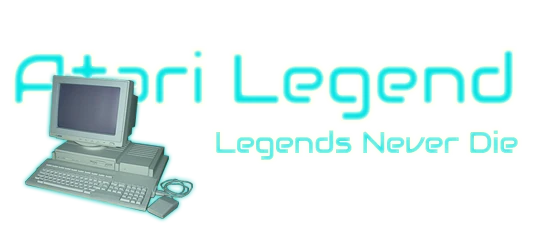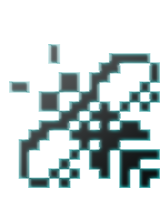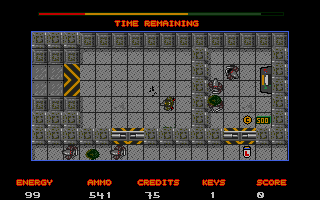







Marcus Platt is the creator of the hidden gem STORM '94. His game was based on some old game logic he once made in the 80's on a ZX Spectrum. But it never turned into a game. Until he witnessed Alien Breed on his friend's Amiga. STORM '94 is a fantastic game that deserves way more attention. You have seen the video, now it is time to learn even more about the man behind the game.
There is currently no profile available in our database
1) Introduction
2) The first computers
3) The Atari ST
4) Storm and Storm '94
5) Alien inspiration
6) Creating Storm
7) Fugitive Freelancers
8) Commercial or PD
9) Gameplay
10) STe samples
11) Alien Breed clones
12) A career in game making
13) Magazine reviews
14) Life after Atari
15) Favourite games
16) Atari today?
17) Idols
18) Final words

At school, a friend of Marcus managed to created a game on the 380Z called Canyon Crash, a rudimentary version of a Flappy Bird like game.

Even though the playfield is a bit small and the graphics are not comparable to Alien Breed, it is in its gameplay where this game really shines!
1) Marcus, please introduce yourself to the people who haven’t heard from you?
Hi, I’m Marcus - Twitter. Born in the 1970s, I grew up in the UK developing a passion for computers and video games. In the 90’s I wrote a couple of licenceware games in my spare time for the Atari ST, as I considered a career in the video game industry.
These days rather than code in my spare time, I like to wander with a camera, explore in our Campervan or write. I’ve just started to share my tech and productivity thoughts on Medium as I try to start the novel that I know is hiding inside me! I also support Aston Villa football club and have come to terms with Jack Grealish joining Manchester City ;-)
2) When did you first get in touch with computers and which machine was it?
My first encounter with a real computer was around 1983. A Research Machines RM 380Z could be found in a school cupboard, only accessible if you joined an after-school computer club. I can still remember the glow from the green screen.
There was an older student who managed to write a simple game on this machine where you had to avoid randomized wall of lines drawn either side of the screen. A single space bar altered the diagonal course of your pixel on the screen. The idea was to avoid crashing into the walls either side, but the gap got less and less as the game progressed. I think we called it Canyon Crash or something similar and he kindly talked me through how it worked. Looking back at it now, it was similar to Flappy Bird in its gameplay but with a single pixel line as the bird! The 12 / 13 year old me was completely blown away, my imagination was ignited, and I was hooked on computers and technology.
The first computer I owned was an 48k Sinclair Spectrum. This is where I taught myself to program in BASIC and created my first games that I shared with friends. They were never released commercially as It was all just for fun at that time. My ZX Spectrum was also a games machine. I’m sure my career would be in the video games industry if it wasn’t for Football Manager, Jet Pack and Manic Miner and others. So I guess I owe them all some thanks for avoiding game development studios! ;-)
3) When did you buy an Atari ST and why?
My friend had a Commodore 64 as we grew up and we were always in heated discussions of the merits of both ZX Spectrum and C64’s. Then one day he announced he had bought a Commodore Amiga, so to keep our rivalry going I got an Atari ST around the same time. I also had another friend that owned an Atari ST, so I knew I had a library of games I could borrow.
4) You only created one game, released in 1994, called Storm ’94? Can you tell us a bit about the history of this project? When did it start? Why did you want to create a game? And how long did it take to finish it?
Actually, there is a prequel to Storm ‘94, imaginatively titled Storm! ![]() This was coded with STOS, but it didn’t have the most fluid scrolling or game play and received some encouraging but average reviews. Storm ‘94 was the updated version as I improved the gameplay, the code (as I was always learning!) and used some additional STOS extensions to make it more professional.
This was coded with STOS, but it didn’t have the most fluid scrolling or game play and received some encouraging but average reviews. Storm ‘94 was the updated version as I improved the gameplay, the code (as I was always learning!) and used some additional STOS extensions to make it more professional.
I guess my drive to write a game was to create something that I was proud of, and the hope that one day it would lead to a job in the video game industry.
The games were all written in my spare time, juggling my job, drinking beer at weekends and keeping a girlfriend happy. If I was to estimate a time, I’d say 12 months for Storm and another 6 months for Storm 94?
5) Storm is an Alien Breed/Gauntlet clone. Is this where you got the idea from?
Both Alien Breed and Gauntlet were inspirations for my games. I had a Commodore Amiga owning friend telling me how amazing Alien Breed was, and that the Atari ST could never do anything like it! I must have played Alien Breed a couple of times on his Amiga to get a feel for the game, but I wasn’t making notes on how to clone it.
The sparks of the game's mechanics started many years before I even owned an Atari, back to when I was learning to code on my ZX Spectrum. Getting an object to relentlessly chase down another object was a huge success of my budding programming skills. Originally my thoughts for a game that used this logic was going to be a D&D maze setting (like Gauntlet). But at the time my vision was greater than my Spectrum coding skills and I never progressed it beyond this.
The Gauntlet Arcade game has a very special place in my heart. Not just because that arcade machine ate a lot of my money! Having 4 players huddled round the machine was special. Even to this day I might announce to my younger team members that “Blue Elf needs food badly!” as I head to lunch.
6) Did you create the complete game all by yourself? Code and graphics? And which tools did you use to create the graphics? And what makes this game STe only? Do you remember any of the technical details?
The Storm games were coded solely by myself using STOS, plus the Missing Link and Misty extensions, I think. Not having a graphic designer to call upon, nor having any talent myself meant that the graphics were mostly borrowed and changed from various games that I’d decompiled to look through the code. To my shame I even ripped the title screen spaceship from the Turrican game. I did mirror the graphic in a hope no one would notice, or I wouldn’t annoy anyone too much!
I think the STE requirement came about with the need to implementing smooth hardware scrolling in Storm 94. One of the main issues with the original Storm game was the sluggish scrolling, which I think was ST compatible. I think the Missing Link extension made it super easy to get some great smooth scrolling without the need for any assembly code. I wanted to improve the original Storm game following the encouraging but average reviews it received.
7) You used the developers name Fugitive Freelancers? Why and what does it mean to you?
The original idea was for 3 friends who met in the after-school computer club and then played D&D together were going to design and create video games together. Fugitive Freelancers was born one evening around a friend's house as we looked for a professionally sounding name. We’d get together and bounce ideas around until the early hours every week, but nothing progressed from the paper designs. We enjoyed many great nights together firing ideas around. Eventually the Fugitive Freelancers became just me, as my desire to code a game never let up like it did for the others. Basically, I kept the Fugitive Freelancers name as I thought it made me sound more professional and bigger than just me back then!
8) STORM was programmed in STOS for the STe only. But it is not very obvious, it looks really professional and is very well made. Yet it was released as a PD game (LAPD library). Did you ever consider getting it published as a commercial release?
To me back in the 90’s, if you wanted to release a commercial video game you had to write it in assembly language, anything else seemed amateurish. Makes absolutely no sense whatsoever now I think about it. But back then, that’s what I thought. So I didn’t even try to find a mainstream publisher, afraid of the rejection letters! “STOS? That’s Basic isn’t it? HAHAHAHA! There’s the door!”
I sent a couple of demo disks out and was approached to release it as a PD licenceware game with LAPD. They asked me for an exclusive deal after seeing the demo. I can’t remember the contract details and how much I was paid out of the £3 disk they charged, but I’m sure I’d reject it today! At the time I was dizzy with excitement that someone wanted to distribute my game. Getting paid to do something I enjoyed was just a bonus!
9) STORM is a very well balanced game. At first it seems pretty harsh, with an unforgiving time limit, lots of back tracking and trial and error. I’ve also noticed the elevator keycard is placed in different spots each time you play a level. But on the other hand you implemented a password system and other nice features like the ability to buy ammo and health. It is a very satisfying game. What do you consider the coolest features in the game (gameplay wise)?
Thank you, I really appreciate those words. There was a lot a tweaking to make the game hard, but not impossible as I updated from the original code from Storm to Storm 94.
However, the elevator key card random spawn position gave me a major issue following the release of the game. The spawn point of the key card was a randomized location on the map, with a few rules as to where it could be placed. Far enough away to be fun, not a wall or door tile, must be a floor tile and some other variables. In one of the maps I created (all hand-built in a mapping tool) I got lazy and accidentally left what should have been solid wall tiles empty, to save around 5 minutes of filling in the whole area with wall tiles. This inadvertently created a relatively small part of the map with floor tiles that the player could not reach. Of course, in my testing the key never generated in this small part of the map.... and then the complaints started coming in about a ‘broken’ level of the game. Sometimes the key would appear in this area on this one level and users couldn’t find the key at all! I was able to fix the issue fairly quickly once I found the problem, releasing the updated code to LAPD for future distribution. But back in the early 90’s after you’d sold a floppy disk, fixing issues like this wasn’t really possible. Luckily I was able to give any upset users the code to the next level, and that seemed to keep everyone happy.
If that happened today, I’d most probably be abused on Twitter for months before getting doxed or swatted by some irate teenager! ![]()
To me, the coolest thing about the game was associated with a sentimental value it had to me, the aliens making a direct path to the player. It is nothing special, some simple rules to keep the aliens heading to your location. But the code I used was first developed on my ZX Spectrum many years before as I taught myself to code. I still recall proudly looking at my TV screen with my Spectrum connected and using the WASD keys to move a ‘+’ symbol around the screen whilst being chased by a number of ‘O’ symbols. This was the same code logic, in a full game I made, and I was so proud. It seemed a vindication for all those hours of coding in my bedroom on a rubber Spectrum keyboard.
10) I’ve noticed some really great MOD music and samples in game. I recognize some of the samples from the game Pinball Fantasies by DICE. Do you remember ripping these samples? Or where did you get them from?
Alas, I can’t recall where I ‘borrowed’ the sound effects or music from. Apologies for any copyright infringements if it was yours.
11) STORM was (by my knowledge) the first game which was considered a true Alien Breed clone. 2 other games followed. The most well known is Alien Thing by 999 software, which was also programmed in STOS and a year later we got Alien Blast, also an STe only clone. Have you ever played these games?
I think Storm was the first Alien Breed clone on an Atari, I don’t recall seeing one on the Atari prior to my release. However I don’t' recall playing either of those later games as I think around the time they were released (95?) I had already moved to an i486 PC. Also, it might seem strange but by the end of Storm 94’s development I was fairly sick of the top scrolling shoot’em up genre and was happy never to play one again!
12) You clearly have talent in game design, and you may not know it, but STORM is considered a hidden gem to some (including me). Yet it doesn’t get the recognition it deserves. It seems almost hard to believe this was the only game you ever made. Did you ever try to pursue a career in game making?
That’s very kind of you to say that. To this day I am proud of the game, it might not have made me rich but I found it incredibly enjoyable to design and code.
I tried to teach myself Assembly Coding after Storm 94, thinking that was the only real way to break into Games Development. I failed miserably. It’s really hard! Much to my regret I never had the confidence to try and progress a video game career due to the notion of not being good enough.
I guess Imposter Syndrome held me back a lot, I never actually thought I had the talent to be successful in Video Games. Maybe when I get my 2nd life I’ll not listen to the doubts in my own head so much!
13) Was the game ever reviewed in any major Atari magazines? If so, do you remember which one and which issue?
There were a couple of reviews of Storm and Storm 94 in some mainstream Atari Magazines, I did keep them, but after 30 years of moving homes I think I left them behind in a loft somewhere. However, I was able to find a couple of magazine scans online on AtariMania.com.
Re-reading them today filled me with pride again some 30 years later.
ST Review issue 26 - News update
ST Review issue 27 - Reviews
14) What did you do after the Atari ST? (professionally)
With the need for a regular income and not making any progress in teaching myself assembly code, I concentrated on my engineering career, got married and put games development lower down the priority list. After a few years I got a job in IT Support at a large manufacturing company. Somehow, I volunteered myself to look after the telephone system and my career pivoted towards telecoms with Avaya & Vodafone. Now I’m an IT Consultant, managing a small team of telephony engineers in London. I think my early programming exploits taught me some valuable skills around analytical fault finding, so I don’t look at it as wasted time.
15) Are you a gamer? If so, what is your all time favorite game, retro or new?
I still game when I get the opportunity. I’ve got a PS4 but hardly find the time to play it that often. When I do it’s almost complete frustration of powering on the PS4, it needing an update, update it, launch the game, that needs an update also, wait 2 hours for 40GB to download and install. At last! Press Start as the wife calls “Hi Honey, I’m home!”
I do have some old gaming books, magazines (Edge Years 1 and 2!) and collector's edition games hidden in the garage still. Mainly PlayStation and some old hardware (GameGear / Nintendo 64) I need to decide what to do with them soon!
As to my favorite game, Journey on the PlayStation 4. The music (composed by Austin Wintory), is amazing and the gameplay fun and intuitive, and it’s emotional. For some reason back in 2012, the 42 year old me got so caught up in the game I actually cried as I completed it for the first time.
16) Are you still into Atari today?
I own an number of Atari t-shirts and some Atari VCS emulation hardware/software too. I also read Atari articles and watch any documentaries whenever they pop up. But nothing more than that, no forums or such like anymore. I loved the ‘Atari: Game Over’ documentary and the ‘Halt and Catch fire’ series. Whilst not Atari focused you can see growth of video games in the 1980s and 90s through it.
17) If you could have a drink with anyone, who would it be and what would you ask? (who do you look up to?)
In the early 90’s my Amiga friend and I went to a video game show at the NEC, a large exhibition centre in Birmingham (UK). My friend nudged me as we walked the loud colourful isles. “Look! Look over there!” I was dumbstruck as Jeff Minter was walking towards us. Jeff was a God to us both in the Video Game industry, so many amazing games, Attack of the Mutant Camels, Gridrunner, Llamatron, Tempest and loads more. We plucked up the courage to say hello. They say, never meet your heroes. I’m pleased to say he was the nicest guy you could ever wish to meet, offering some sound advice about getting into the game development business and just generally being a top chap.
So, If I got the chance I’d like to buy Jeff a beer, just to say thanks for giving his time to 2 dorks from Birmingham back in the 90’s.
18) Do you have any last words of wisdom to share with the Atari community?
Words of wisdom? I am not sure I am that wise!
I would say thank you to everyone that spent their hard-earned money on any PD/Shareware software in the 90’s. Each purchase you made helped a small developer continue on the path towards their dreams. Sometimes those dreams faded or changed like mine, but at that moment your small validation with a purchase kept a dream alive. So thank you all.
If you pirated my game. I forgive you!
Full documentary available here!
Please log in to add your own comment to this interview
August 5, 2025 by grams88
Martin Brownlow is a living legend. Best known among ST fans for creating the beloved PD/shareware classics Grav and Grav 2, his games are still cherished by many to this day. From a young age, Martin knew he wanted to make games for a living...and he made that dream a reality. In fact, he’s still doing it today. Discover the full story and much more in this exciting new interview.
October 4, 2024 by grams88
Stacey Jamieson began his career at DMA Design, working on titles such as Oh No! More Lemmings, Walker, GTA and others. Over the years, he moved on to Electronic Arts (EA), where he contributed to major games like the Star Wars Battlefront series, Mass Effect, and Need for Speed. Today, he is the co-founder of Expression Games, where he continues to pursue his passion for game development. What an exciting career!
July 29, 2024 by grams88
Who doesn't love a good underdog story? Chris Sharp is a noteworthy apprentice of the renowned François Lionet, as he mastered the art of coding with the almighty STOS Basic. Chris crafted a few games for our cherished ST, including fan favourites like Magic Tomb and the Freaked Out series. Intrigued? Dive into our interview to revisit the era when game development could still be a solo endeavour.
July 16, 2024 by grams88
When Sega released its Master System, it came bundled with the game Alex Kid. To this day the game remains very popular, loved by many. One of those people is Terry Lloyd. More so, Alex Kid was the main inspiration for the Atari ST platform classic Axel's Magic Hammer. But that is just one of his many accomplishments. Terry has been around the block. Working as an artist and game designer at the beginning of the 80's for Gremlin Graphics, he then moved on to Core Design, which he helped get off the ground. During the 90's he contributed to founding the company Malibu Interactive. On the Atari ST, Terry's resumé include Dynamite Dux, Car-Vup, Rick Dangerous 1 & 2, Torvak the Warrior, WarZone and many more. Read all about this veteran of the games industry in this exciting interview.
April 18, 2024 by grams88
It doesn't always have to be about computers, coding and graphics. Adrian Powell, the artist behind the original Lemmings game, crafted all its artwork, including box art and promotional materials. His passion for painting lemmings has persisted over time and he is still painting lemmings to this day. Powell's work remains influential and has helped selling millions of copies of this classic (ST) game.
Currently 0 registered users online
In the past 24h there were 3 registered users online